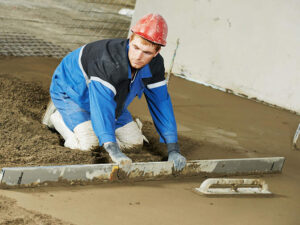Polished concrete has quickly become the ultimate no-wax material for flooring. Having wide experience and appropriate floor grinding equipment, concrete polishing contractors can absolutely grind concrete surfaces. Whether old or new and turn it into a high-gloss finish that coatings and additional waxes will not be needed. The high factors are the polished concrete’s performance and superior durability. Undoubtedly, more commercial warehouses, more facilities, and homeowners are looking forward and catching on towards these smoother, high-luster floors. And most importantly, concrete contractors are using the construction scheduling software for the overall concrete project’s management.
In this blog, a full overview of polished concrete floors alongside the design options, requirements, benefits, and maintenance needs will be discussed.
We will also discuss a full overview of polished concrete floors alongside its different methods, types, benefits, and of course, finishing tips for polishing concrete.
What is Polished Concrete?
A polished concrete floor typically has a mirror-like, glossy finish. The available design options, particularly for polished concrete are extremely vast. There are plenty of colors available and created patterns with embed aggregates, saw cuts, and even interesting objects. The floor’s reflectivity can be also controlled by using any different levels of concrete polishing. Commercial buildings are where polished concrete is most popular to use because it is easy to maintain. Project managers for concrete projects are very particular in polishing. That is why it has become one of the many suggestions they prioritize to their clients. Apart from ensuring they deliver the specifications and client’s expectations, concrete experts are using a project managers software that is ultimately beneficial to the project and the services they offer.
Below are other most common areas where polished concrete is used to apply:
· Retail stores
· Office buildings
· Large warehouses and outlets
· Private Residences
· Auto showrooms
Types of Polished Concrete
It solely depends on the diamond grits that the concrete subcontractors have used to polish the floors. Achieving different ranges of sheen is easy, from matte to shiny mirror-like finish. In fact, there are many different amounts of aggregate exposure available right now, including from cream finish having no exposure to full aggregate look. And also, several emerging technologies are deployed now at work, one of which is the construction management software like Pro Crew Schedule. This software tool is cloud-based and comprises unique project management and scheduling features that essentially help the contractors and subs work more collaboratively.
Now, let’s take a look first below of some different types of polished concrete.
· Cream Polish – it will give you the most consistent and smoothest sheen possible when the concrete floor is polishing. This type of concrete accepts dyes and stains in a consistent manner and more readily.
· Salt and Pepper Polish – the look it gives is the most achievable because it will remove stains and colors well enough and will absolutely hold a crisp of glossiness. It might expose cracks or perhaps small holes that can be slowly visible in the finished floors.
· Aggregate Polish – out of the three mentioned previously, the aggregate polish is the least look forward to because of its expenses. However, it has a direct place when being finished the right way and have a very desirable look. But there could be some limitations on concrete floors that vary from its conditions.
Concrete Polishing Methods
Concrete can be polished either by two methods. For easy implementation of such methods, concrete contractors are using builders schedule software. All tasks and the assigned crew members can all be tracked and monitored anytime and anywhere. Since the application is cloud-based, accessing it can be done every single time. Hence, contractors can consistently be updated.
1. Wet Method
In this type of method, particularly during the grinding process, water will be used to cool the diamond abrasives. It will then minimizes the amount of dust formed during the polishing process. The water that has been used in this method is proven to help reduce friction. Additionally, it acts as a lubricant, hence, it increases the longevity of polishing abrasives
2. Dry Method
When it comes to dry polishing method, there’s no water to be used during the process. When it comes to floor polisher, a certain containment system polisher is going to be firmly attached so that the dust created is immediately taken by this arrangement by vacuum effect. It absolutely clears the mess alongside the process, which is considered an added advantage compared with the wet method. The dry method is typically used in industrial floor polishing because it was more convenient and environmentally-friendly. The same way for contractors preferably using a subcontractor scheduling software because the application itself is proven by experience to be advantageous. Work has become more productive and the team is becoming more collaborative because communication has become consistent. Software applications like this is definitely a must-have and must-use in work.
Benefits of Concrete Polishing
Concrete polishing refers to a process of restoring and preparing concrete similarly to re-sanding hardwood floors. It is typically used in new construction and also remodeling projects to upgrade or renew flooring. The concrete polishing process begins with a polishing machine that will use increasingly finer grits of diamond-shaped embedded discs to sand down the concrete surface until achieving the desired level of glossiness.
The benefits of making concrete floors polished range from practical to aesthetic. Take a look below:
· Virtually maintenance-free – commercial properties are where polished concrete preferably, was chosen to get into all because of the design features. When concrete is polished, it produces a surface that typically needs to be dusted or swept or wet mopped on most rare occasions. Polished floors are capable of maintaining shininess and glossiness and it doesn’t create dust; hence, cleaning every day cannot be impossible.
· Affordability – this type of floors is one of the few economical choices and is the best choice for any design projects. Polished concrete is cost-effective when it comes to its installation and because of its sustainability. Replacing or repairing these floors isn’t done regularly because it can able to last longer.
· Safety – because of the mirror-like finish and glossiness effect, polished floors tend to increase its visibility. Thus, it decreases the chances of accidents like falls and slips. The finish that was being applied to the concrete can also turn the flooring lesser slippery when wet.
· Durability – this type of flooring tends to last longer in comparison with other flooring options. The polished floors are impermeable to damage and cracks. It doesn’t break down easily or need urgent restoration or refinish, unlike other well-known flooring.
· A variety of styles – concrete polishing can absolutely deliver any design aesthetics. Having mirror-like finishes is quite an advantage because by building a foundation with laser cuts or perhaps utilizing a vast array of colors in an exciting pattern, the choices and preferences are unlimited. There is also a control that can be implemented when it comes to the level of glossiness for these floors.
Other included benefits are the following:
· Low maintenance
· Improves natural lighting
· Mold growth and insect attack aren’t occurring
· Sustainable since existing materials are used
· Easily cleaned using neutral cleaners and water
· Can withstand severe industrial environments
· 3D forms can be achieved easily
Tips on Finishing Polished Concrete
The success of a polished concrete surface isn’t resting solely on the concrete processing steps. Thus, careful planning in terms of the project from mixing designs to the final protection will help a contractor to achieve a successful end further. Above all, what really makes the concrete polishing a success is that concrete contractors use a crew schedule software that aims to efficiently supervise every phase of the project, the entire crew members, the assigned tasks and many more related tasks. Through the use of these applications, work becomes easier to manage and success is easy to obtain.
Take a look below of 3 beneficial tips to finish a polished concrete correctly:
1. Specifying a polish floor
The very first crucial step is to identify the desired finish. Designers and contractors often specify the processed concrete floor. There are several considerations to be made in order for the surface to cut, decorative applications like saw cuts, clarity of reflection, etc.
Right after the desired look has determined, what next to be written is the specifications for completion. A certain particular section referred as “Division 3 – Concrete” is known to be a section wherein of the specifications for new concrete will begin. The entire section will comprise all specifications for curing, mix designs, control joint placements, finishing, protection and even processing methods.
2. Determine the mix design for the concrete
This primarily varies on weather conditions of the area where the construction site is currently located. If in case the entrainment is essential owing to the weather conditions, then it should be limited to only 3% of the entire lot. Ideally, 20% of the cement weight should be used for the concrete structure. The concrete coloring must be done in a way that it would never look like stains on the floor.
3. Apply penetrating hardeners to the concrete
This is in order to densify and solidify concrete surfaces. Penetrating hardeners are usually applied after the first step from the grinding process. What’s more surprising is that these products can be applied and use to either existing or new floors. It typically works by chemically reacting with concrete in order to form a crystalline, hard structure. Applying this, it offers extra protection against staining and water penetration and at the same time, it prevents dusting.
Key Takeaways
Polished concrete flooring is undeniably growing in so much popularity, referred to as one of the best-finished flooring options in commercial and home properties alike. With the benefits that have reached far beyond the beauty it gives, it was never a question that these floors can absolutely be found easier now than before.






1 thought on “Polishing Concrete: Finishing Tips for Concrete Contractors”
I like how you mentioned that cream polish can accept dye and stains in a consistent fashion. My brother needs to polish his concrete for the opening of his new office next month. I’ll share this article with him so he can get more ideas about what kind of polished concrete he wants for his office.